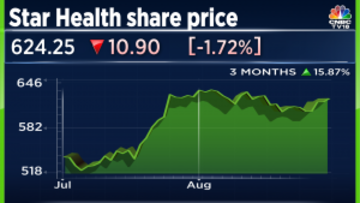
Shares of private health insurer Star Health and Allied Insurance Company Ltd have fallen 13 percent in the last one-year period. The stock, which was listed at Rs 848.80 on December 10, 2021, is trading 26 percent lower to the market debut day level.
In the current session, the stock slipped 1.23 percent intraday to trade at Rs 628.15 against the previous close of Rs 635 on the NSE. On a year-to-date basis, Star Health shares have gained 7.50 percent.

Domestic brokerage house Motilal Oswal have assigned a 'buy' rating on the stock, included in portfolios of Rekha Jhunjhunwala and her late husband Rakesh Jhunjhunwala. The brokerage expects the counter to reach the Rs 730 level in the next 12 months, implying an upside of 16 percent.
Rakesh Jhunjhunwala was a promoter of Star Health. He (14.24 percent) and Rekha Jhunjhunwala (3.07 percent) held 17.31 percent stake in the company as of the June 2023 quarter, according to shareholding pattern data available on BSE.
According to Motilal, Star Health is expected to clock a 20 percent retail health premium compound annual growth rate (CAGR) over FY23-25 led by an increase in sum assured per policy, a price hike in its flagship product, and deeper penetration that is driving growth in the number of policies.
The management is intensely focusing on growing the business through the Banca channel, with the help of benefit-based products that have much higher profitability than retail health products, the brokerage said. The share of banca stood at 5 percent in FY23 and is expected to double by FY25.
The share of specialised products too has continued to rise and was at 15.5 percent in FY23 versus 11.2 percent in FY21. The contribution of network hospitals to cashless claims has also been rising (67 percent in FY23 versus 55 percent in FY21).
Motilal expects the trajectory to be sustained given the increasing number of specialised products as well as rising associations with hospitals.
Star Health has maintained its guidance of reaching a combined ratio of 93-95 percent, with a bias towards the lower end. "Further, with solvency at 218 percent, we do not envisage any equity dilution in the near term," the brokerage noted.
The brokerage remains optimistic about the overall growth prospects for Star Health backed by its strong growth potential in the retail health segment due to its underpenetration, healthy earnings growth owing to the normalisation of claims ratio, and limited cyclicality risk (commercial lines and motor insurance have high cyclicality risks).
"We expect the company's overall gross premium to report 19 percent CAGR over FY23-25 driven by 20 percent CAGR in retail health business and 10 percent CAGR in group business. Claims ratios are likely to normalise to 64 percent with a combined ratio of 93 percent. These are likely to propel Star Health's profitability over FY23-25," it said.
Star Health has an average target price of Rs 735.67. The consensus estimate represents an upside of 17.26 percent from the last price of 627.40, according to data from Trendlyne.
In terms of technicals, the relative strength index (RSI) of the counter stands at 58.6, signalling it's trading neither in the overbought zone nor in the oversold zone. Star Health stock has a one-year beta of 0.3, indicating very low volatility during the period. Star Health shares are trading higher than the 5-day, 20-day, 50-day, 100-day, 150-day, 200-day but lower than the 30-day moving averages.
First Published: Sept 1, 2023 11:55 AM IST
Check out our in-depth Market Coverage, Business News & get real-time Stock Market Updates on CNBC-TV18. Also, Watch our channels CNBC-TV18, CNBC Awaaz and CNBC Bajar Live on-the-go!


2024 Lok Sabha Elections | Why phase-3 is a tightrope walk for all parties
May 7, 2024 1:08 PM
Himachal Pradesh Lok Sabha elections 2024: Seats, schedule, Congress candidates and more
May 7, 2024 12:27 PM

